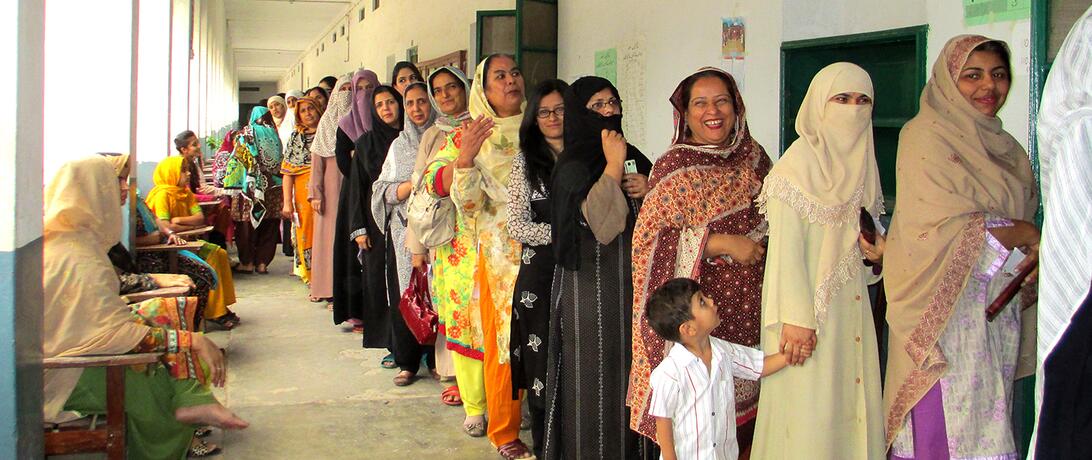
Our Secure Future presents three country case studies to exemplify how new data from the Women, Peace and Security index can be put towards better policy-making.
The 2017 release of the Women, Peace and Security Index was a milestone in the use of big data to understand the connection between the conditions of women and the security of states (which Our Secure Future blogged about earlier this year). Now the question is: How can this data inform the policies of states? We believe that an index can identify states’ key areas of strength and weakness and help policy-makers to identify those most in need of improvement. As such, we have three examples of how the index can be applied to three countries, ranging from among the lowest to the highest rankings.
Pakistan
Pakistan received the third-lowest score of the index and was ranked 150th, only performing higher than Yemen, Afghanistan, and the Syrian Arab Republic. Its low performance received a great deal of public attention, giving credence to the idea of “scorecard diplomacy,” the driving theory behind the index which proposes that low rankings can give countries incentive for improvement.
The country scored poorly in all of the index’s categories, indicating a great deal of room for improvement. However, Pakistan’s scores were slightly higher in parliamentary representation, intimate partner violence (IPV), and organized violence. Specifically, Pakistan received the lowest scores in the Justice section, performing poorly on legal discrimination against women, son bias, and discriminatory social norms. While increased parliamentary representation is always one way in which better equality might be attained, in the case of Pakistan, policy-makers should focus their attention first on tackling legalized forms of discrimination and then on improving women’s access to education, employment and financial inclusion.
Rwanda
Rwanda ranked 94th on the index, which is somewhat surprising for a nation that is so often touted as an example of women’s inclusion with a global high of 56% of its parliament being comprised of women. This high percentage came about after a post-conflict gender quota of 30% was well surpassed.
However, the state still received low scores on a variety of indicators in the index’s inclusion category, such as education, financial inclusion, and cell phone use. The Rwandan government has initiated a variety of campaigns to improve women’s education, but prohibitive school fees continue to exclude many children from education and families continue to prioritize the education of boys over girls when forced to choose. Eliminating these school fees is one way to allow more girls (and even boys) access to education. Similarly, awareness campaigns surrounding women’s rights in the home—including their right to make financial decisions and share bank accounts and cell phones, which often allow for online banking—would address some of the areas in which women’s inclusion in Rwanda continues to lack.
Iceland
Although ranked first in the WPS Index—and also being the first to create a law on equal pay—Iceland’s score still indicated areas for improvement. Specifically, the Nordic country known for equality and excellent female representation in parliament still suffers from a higher-than-expected rate of IPV. While the authors of the index posed the theory that this might be due to backlash in the home or greater comfort of women living in generally equal societies in coming forward, it still identifies a target area for policy makers.
Iceland’s government can use this anomalous low score to implement new laws and protections against intimate partner violence. While further research is needed to examine the reason reporting of IPV is so high in Iceland, state-sponsored research to understand the root causes behind IPV and IPV reporting can help to bring this rate down even further. Understanding that IPV continues to be a problem in spite of women’s inclusion could be the key to better understanding and better policy—and perhaps even penalties—to reduce sexual violence.
How to use the index:
There are three dimensions of measurement in the index: Inclusion, Justice, and Security. Each category has three to five different indicators, which combined add up to 11 total. These include: parliamentary representation, education, financial inclusion, cellphone use, and employment for inclusion; legal discrimination, son bias, and discriminatory norms for justice; and organized violence, community safety, and intimate partner violence to measure security. Countries are scored on a scale from zero to one with zero being the lowest possible score and one being the best possible. Then each of the 153 countries are ranked according to their overall score.
Policy-makers everywhere can utilize the Women, Peace and Security Index. Tell us on Twitter what you think about where this new data can be used with @OurSecureFuture #BetterDataBetterPolicy.
Article Details
Published
Topic
Program
Content Type
Opinion & Insights